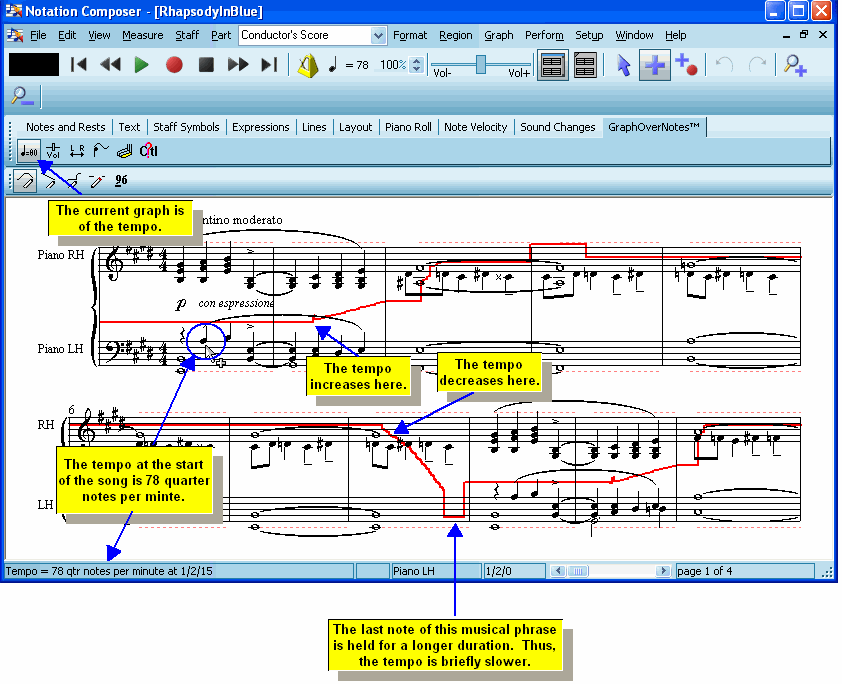|
<< Click to Display Table of Contents >> Viewing and Editing the Music Performance |
  
|
|
<< Click to Display Table of Contents >> Viewing and Editing the Music Performance |
  
|
Preceding sections of this Composer documentation describe how to edit the notation of a song. This section describes how to edit the musical performance of a song.
Composer offers you a high degree of control over both what the song looks like-- its notation- and what the song sounds like-- its performance. The sound editing capabilities of Composer are comparable to the MIDI recording and editing capabilities of a good MIDI sequencer. A major difference between Composer and most MIDI sequencers is that the tools for editing the notation and the MIDI performance are highly integrated in Composer. You can always see a graphical representation of the performance drawn on top of the notes, so that you can clearly see the relationship between the notation and the performance.
You can view the exact performance of notes in the form of Piano Roll Notation, as illustrated below. The left and right edges of the rectangles indicate the timings of the performed note attacks and releases.

The Piano Roll Notation offers you a fairly accurate visual view of the timing of notes. For greater accuracy, you can move the mouse cursor over a note for a report of its exact timing, represented as offsets of the performed attack and release times from the as-notated location and end of the note.

You can easily adjust the exact performed attack and/or release of a note by selecting it and using keyboard shortcuts such as D+![]() to increase the performed duration of the note.
to increase the performed duration of the note.
You can view the individual loudness of notes, such as illustrated here:

To increase or decrease the loudness of one or more selected notes, type L+![]() or L+
or L+![]() . To gradually increase or decrease the loudness over a range of notes, while preserving individual relative differences in note loudness, type C+
. To gradually increase or decrease the loudness over a range of notes, while preserving individual relative differences in note loudness, type C+![]() or C+
or C+![]() (where "C" is for "crescendo").
(where "C" is for "crescendo").
Many types of musical performance data can be of a continually changing nature, such as a continually changing volume level, tempo, or guitar pitch bend. For such kinds of continually changing music data, Composer offers a graphical way to view and edit the performance which is quite intuitive.
The following example illustrates the graph of the rubato (expressively changing) tempo in the main theme of George Gershwin's Rhapsody in Blue.

You can edit the graph with GraphOverNotestm Palette tools such as Draw Curve ![]() , Draw Sloped Line
, Draw Sloped Line ![]() , and Erase
, and Erase ![]() .
.
Also, if your MIDI recording instrument includes controls for volume, sustain pedal, pitch bend, and general MIDI controllers, you can record these types of musical performances live, and merge them with previously recorded notes. This is illustrated in the procedures for editing Note Pitch Bend.
Composer also supports mid-staff instrument sound changes, which are technically "MIDI program changes". For example, somewhere in the middle of a violin part, you can switch from a bowed string sound to a pizzicato sound. Or, in a horn part, you can switch to a muted horn sound.
The high degree of integration of notation and performance editing in Composer means that you do not have to compromise the quality of one (notation or the performance) for the other. You will find that you can productively refine both the notation and performance with the insight you gain by seeing both together. The following example illustrates how you might add a hairpin crescendo mark to match the increasing slope of the volume graph.

If prior to using Composer, you have only been working with the notation, or only working with the MIDI sequencing, you will discover in Composer the rich unified world of both sound and notation of music.